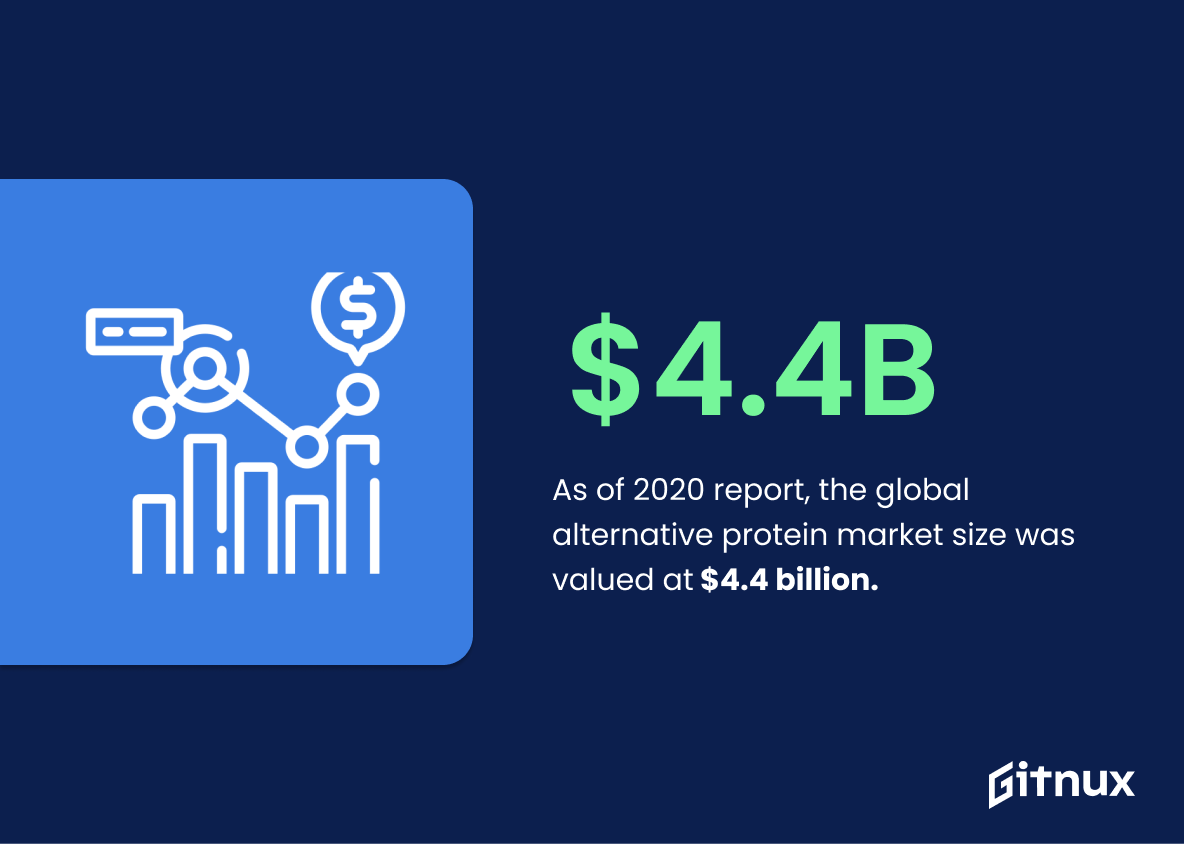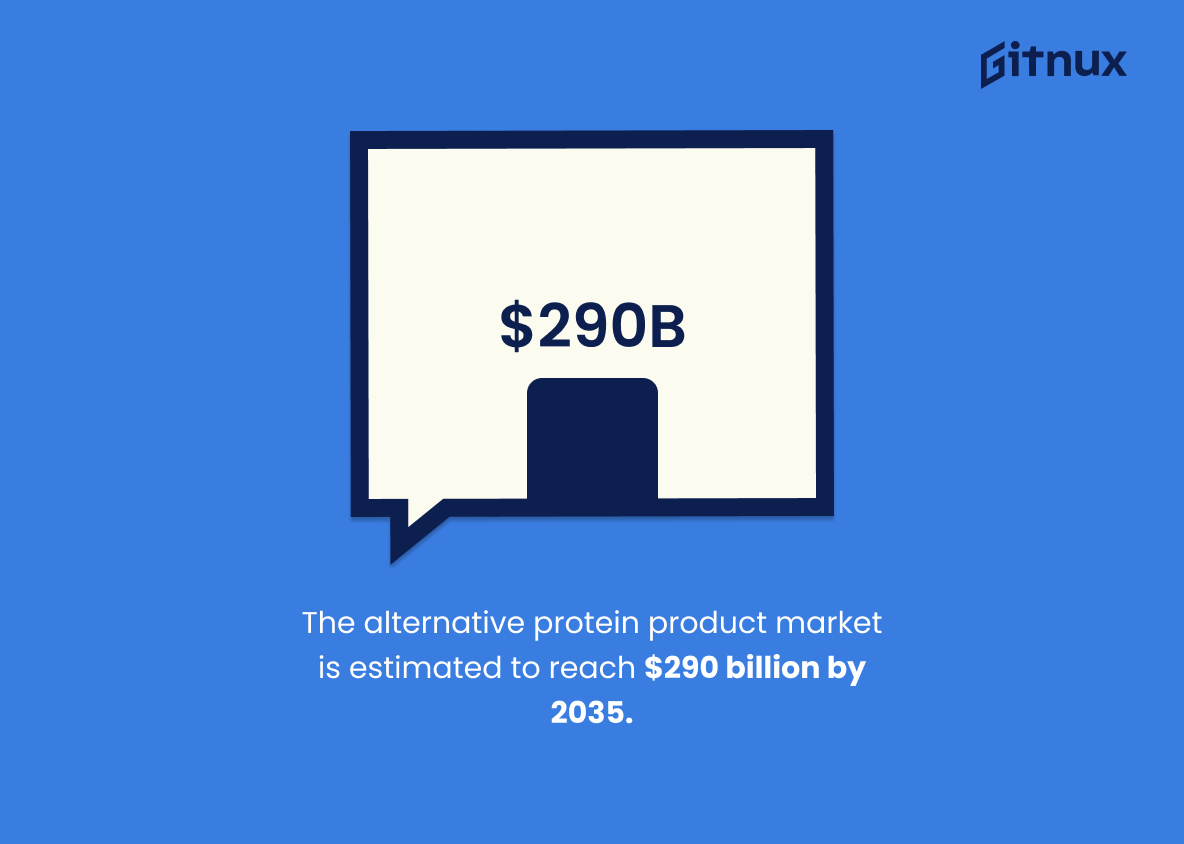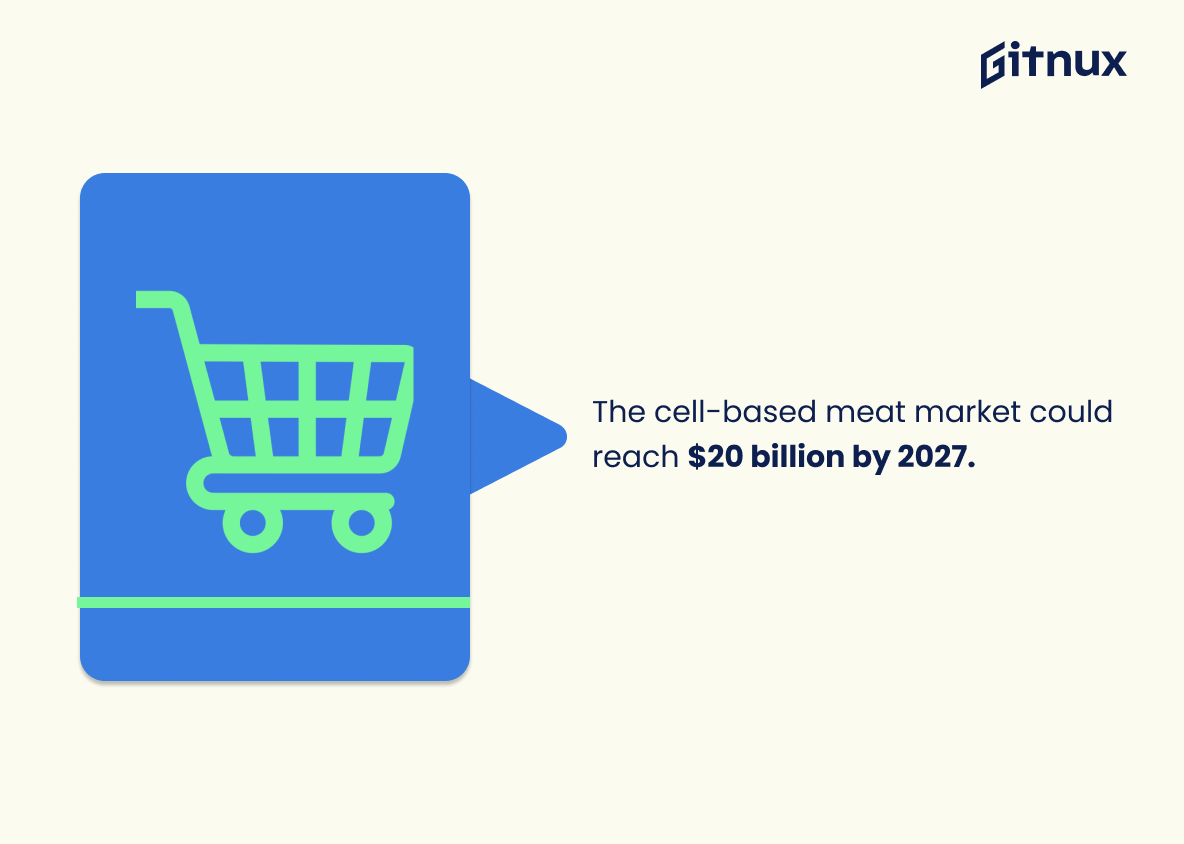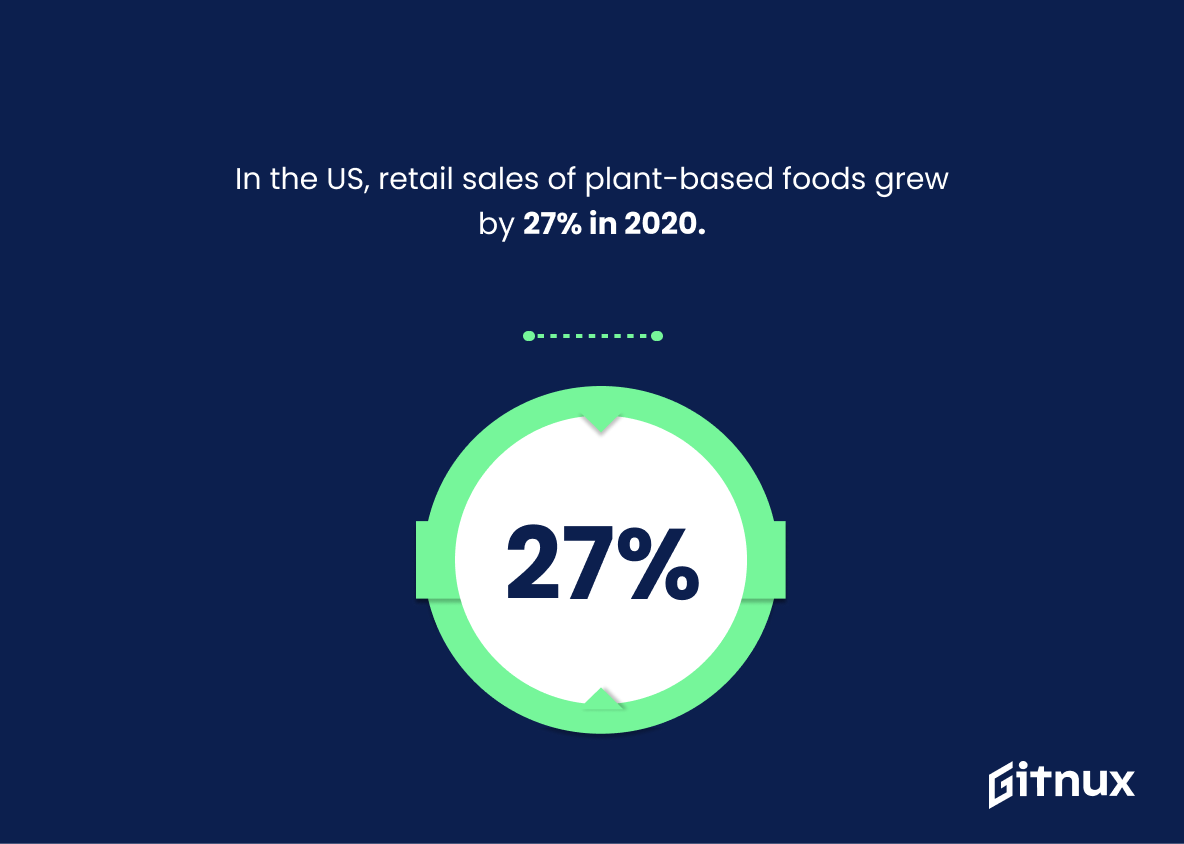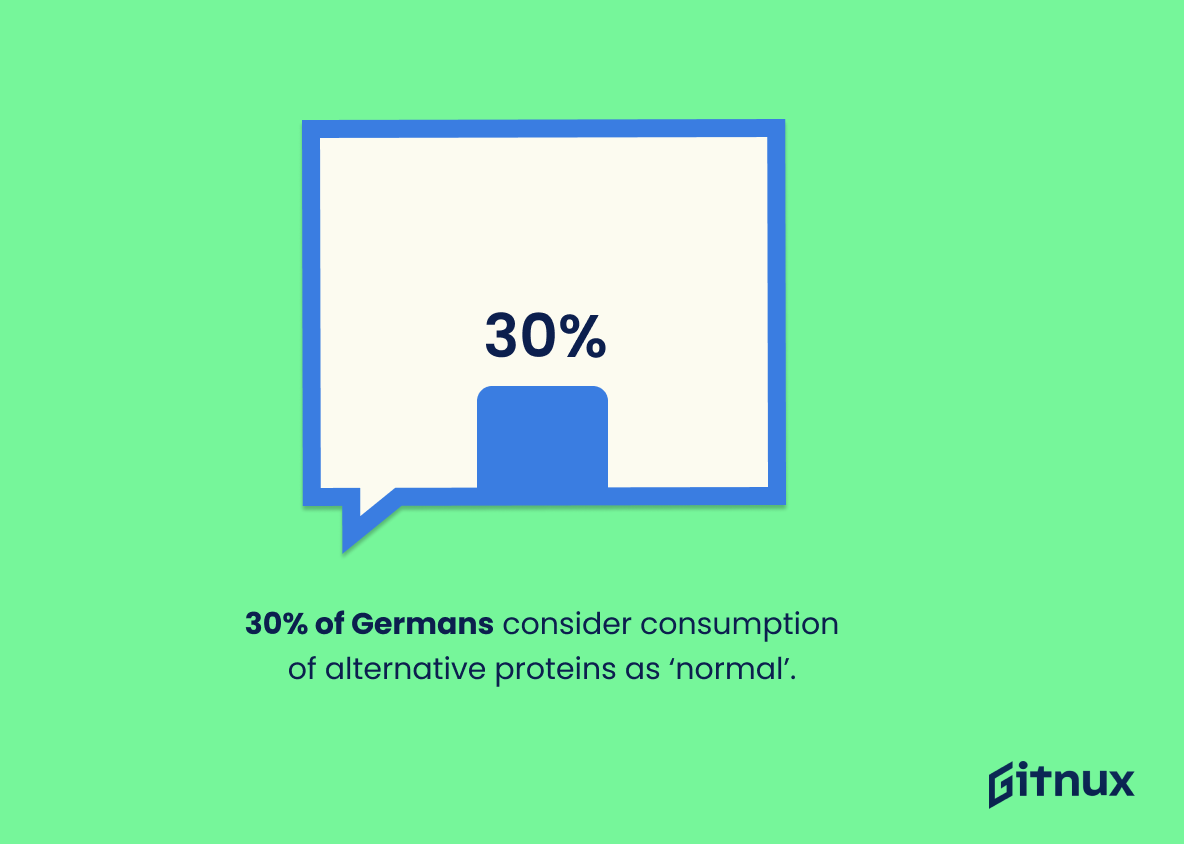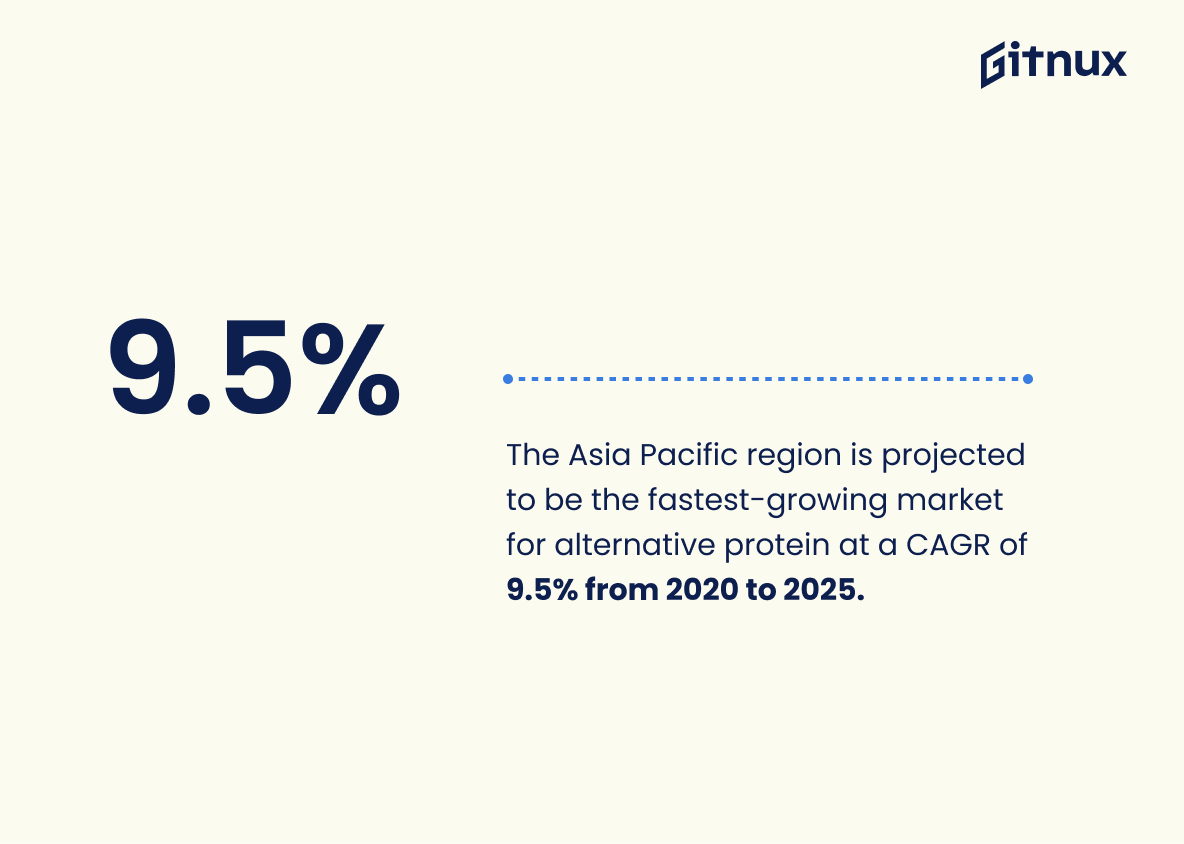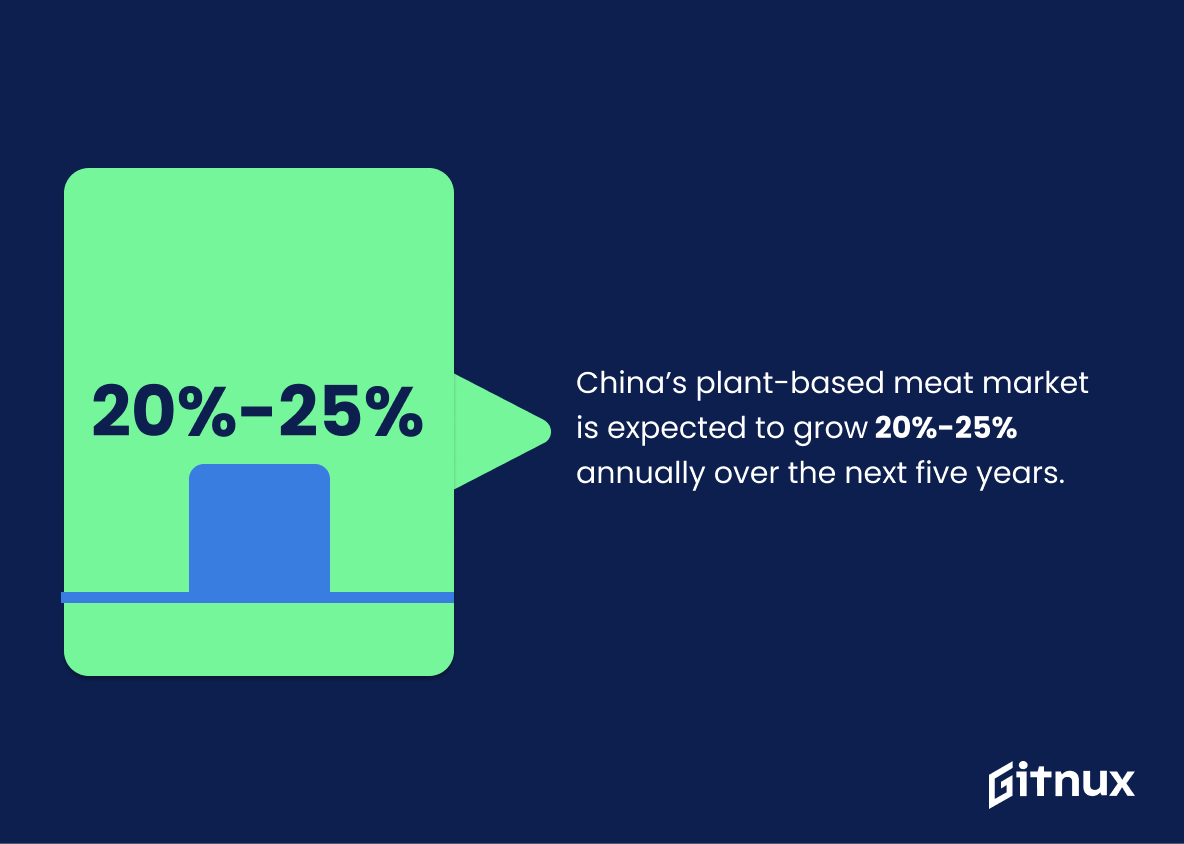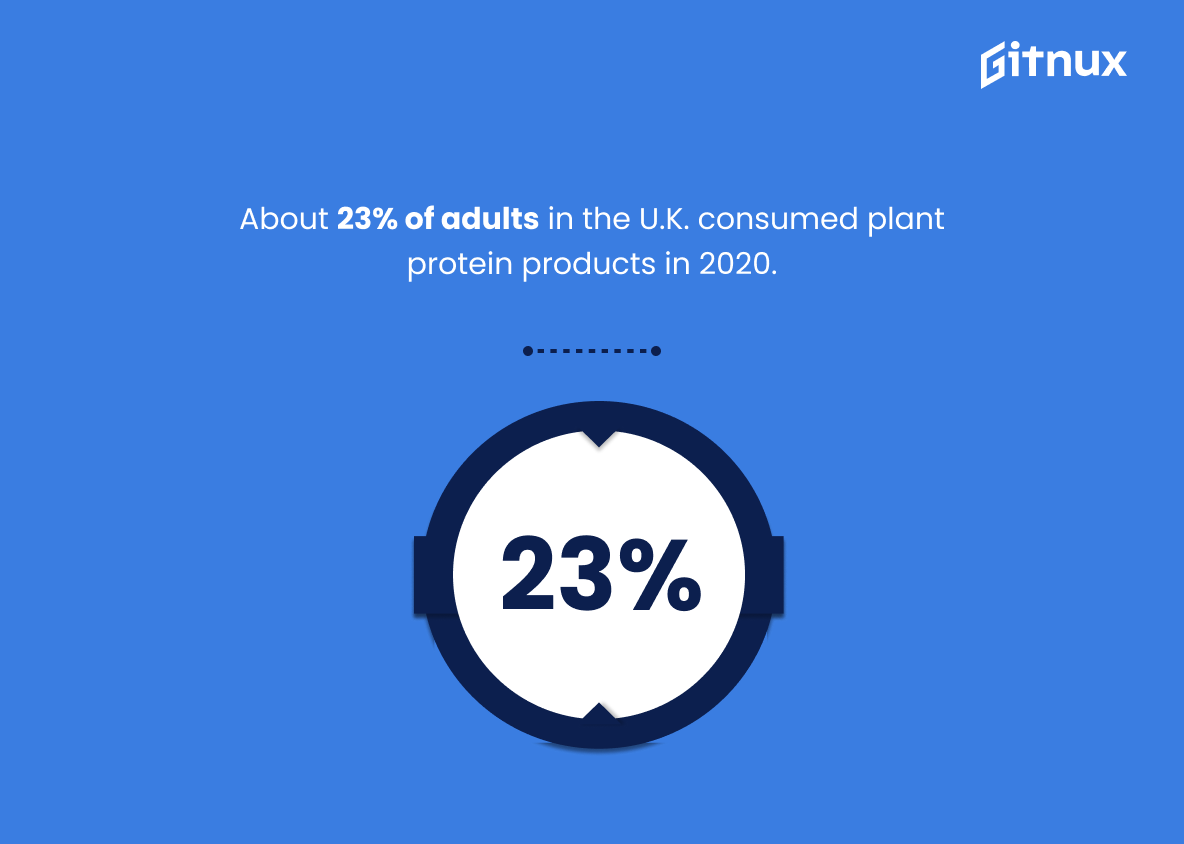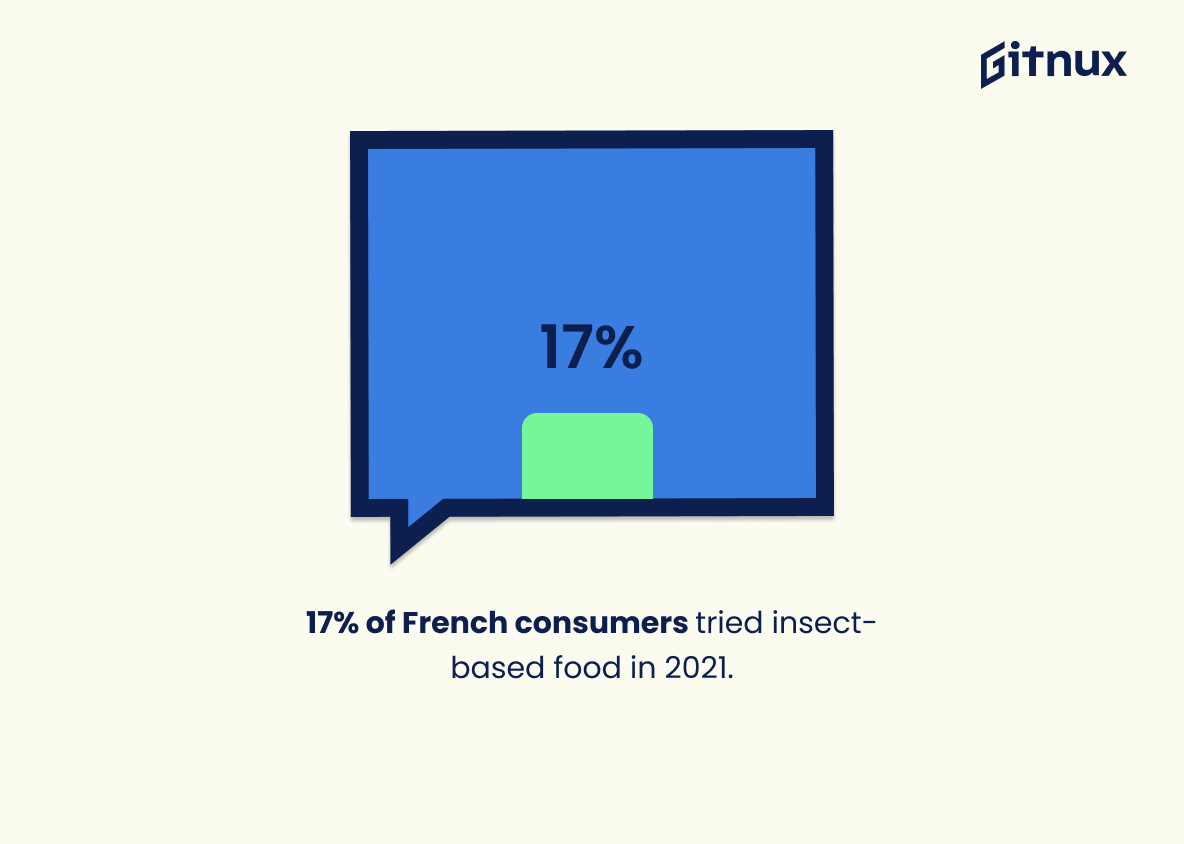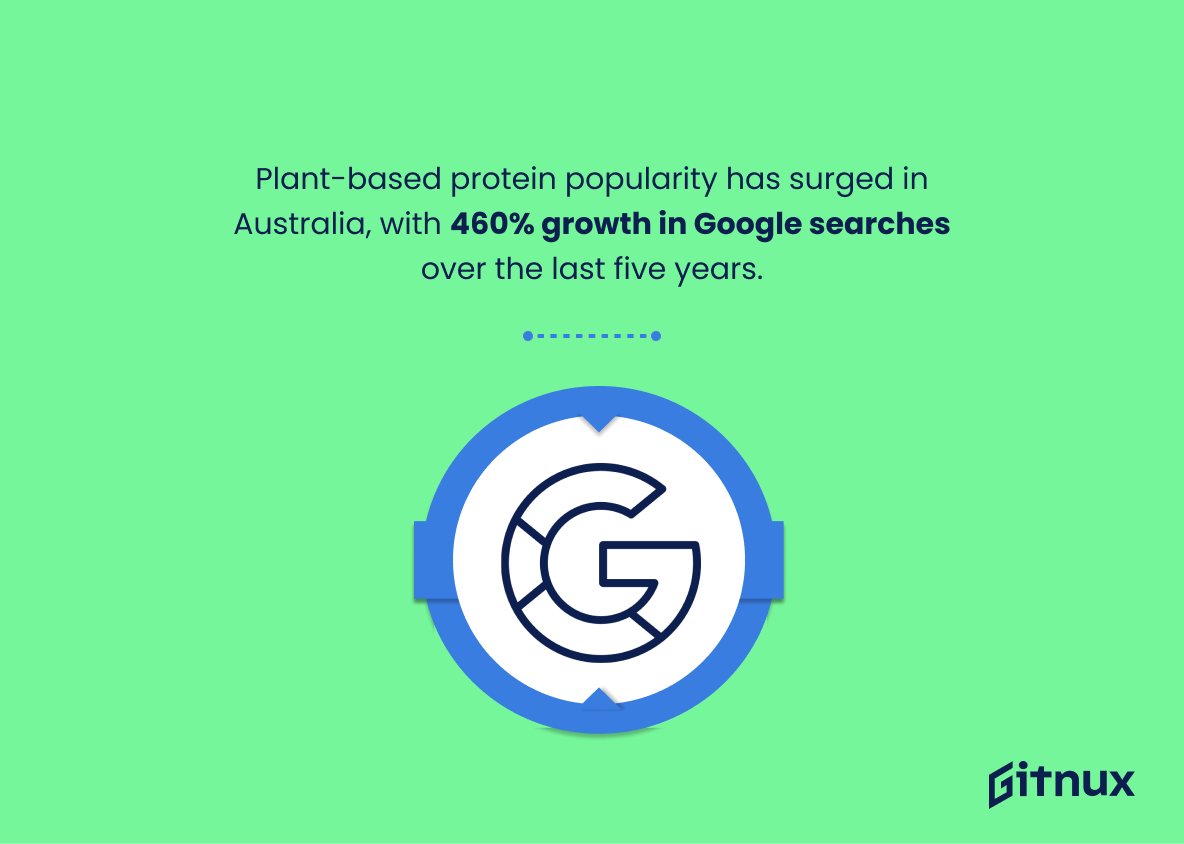In the realm of food technology, one rapidly evolving sector that has been gaining considerable attention is the Alternative Protein Industry. This burgeoning industry, spurred by leaps in innovation, mounting sustainability concerns, and shifting consumer behavior, is offering an array of groundbreaking options that are far from the traditional meat-based protein.
This blog post dives deep into the intriguing world of alternative protein and explores the latest industry statistics that are shaping this evolution. It aims to dissect not only the growth and developments in this exciting market but to substantiate our discussions and insights with compelling, hard-hitting data. Buckle in and join us on this riveting journey that promises to change the way you perceive your plate of protein.
The Latest Alternative Protein Industry Statistics Unveiled
As of 2020 report, the global alternative protein market size was valued at $4.4 billion.
Highlighting the 2020 report showing a $4.4 billion market value vividly paints a picture of the significant financial footholds the Alternative Protein Industry has secured. When dissecting the importance of this figure, we uncover that it’s not just about numbers; rather it acts as an indicator for extensive market growth, innovation and rising consumer interest in the sector.
This dramatic stride in market valuation underscores the potential economic depth, the opportunity for industry expansion, as well as the world’s shifting dietary preferences. In essence, it is far more than a simple financial figure; it serves as a signpost for unprecedented growth and untapped potential within the Alternative Protein Arena.
The alternative protein product market is estimated to reach $290 billion by 2035.
Highlighting the enormous growth projection, such as the alternative protein product market potentially skyrocketing to $290 billion by 2035, provides an eloquent testimony to the momentum of this industry. It underscores the undeniable investment potential and opportunities in this sector for entrepreneurs, investors, and innovators.
It also fosters discussions about consumer trends, sustainable practices, and how disruptive technologies might reshape our food system. As such, it’s a compelling beacon propelling readers toward a richer understanding of the projections, advancements and implications in the alternative protein industry narrative.
The global plant-based meat market is predicted to reach $35.4 billion by 2027.
Forecasting the rise of the global plant-based meat market to $35.4 billion by 2027 casts an exciting light on the arena of Alternative Protein Industry Statistics. This prophetic number stands as a testament to the dramatic shifts in consumer behavior, ethical standpoints, and technological advancements. It paints the unfolding story of a world striving to find sustainable and health-conscious food solutions.
For those working in or tracking the alternative protein sector, it is a compelling symbol of escalating market potential. It underlines the need to pay intense attention to the plant-based meat industry, which is not just a niche trend, but a lucrative and future-shaping economic powerhouse.
The cell-based meat market could reach $20 billion by 2027.
Delving into the future landscape of the alternative protein industry, the prospect that the cell-based meat market could surge to an impressive $20 billion by 2027 offers a dynamic benchmark. This numerical insight really hammers home the colossal potential and the anticipated exponential growth of this fledgling yet fast-paced arena.
This prediction paints a picture of a future where cell-based meat might not just be a novelty, but rather a significant player in the global food market, thereby underlining the transformative potential and the economic vitality of the alternative protein industry.
In the US, retail sales of plant-based foods grew by 27% in 2020.
Peppered within the realm of Alternative Protein Industry Statistics, the noticeable upsurge of 27% in retail sales of plant-based foods in the US in 2020 serves as an illuminating beacon. It not only underscores the burgeoning acceptance and preference for non-animal protein sources among consumers, but it also foreshadows a potential paradigm shift in the food industry.
The statistic paints a vibrant picture of a future powered by plant protein and offers a tantalizing glimpse into the untapped commercial opportunities for stakeholders within this industry.
In Europe, alternative protein’s compound annual growth rate from 2019 to 2021 was 18%.
Drawing attention to the compelling statistic of an 18% compound annual growth rate for alternative proteins in Europe from 2019 to 2021, it’s clear we’re witnessing a food revolution in the making. This dramatic increase testifies to the skyrocketing consumer interest, adaptation and market demand for alternative proteins, completely reshaping the food industry landscape.
Powering more than just the human appetite, this statistic feeds into a tale of a shifting dietary landscape, one driven by increased consumer awareness about health, environmental sustainability, and animal welfare. Consequently, these numbers hold the key to unlocking potential opportunities for investors, startups, and established companies willing to ride the wave of this plant-centric phenomenon.
30% of Germans consider consumption of alternative proteins as ‘normal’.
The versatility of the statistic ‘30% of Germans consider consumption of alternative proteins as ‘normal” brings a compelling argument to the table in a blog post about Alternative Protein Industry Statistics. It’s like unmasking a hidden sentiment – a significant chunk of the German populace not only accepts, but also regards non-traditional protein sources as a standard part of their diet. This number may not seem revolutionary at first glance, but it actually signifies a major shift in dietary habits and food culture.
Imagine one third of a country embracing an industry that challenges traditional protein norms; it translates into an influential customer base ready to fuel the expansion of the alternative proteins market. Furthermore, it sets the scene for other nations and cultures, painting a picture of an ever-changing food landscape that adapts to societal, environmental and sustainability needs. It’s not just a statistic, it’s a statement underlining a transformative trend in the global food industry.
The Asia Pacific region is projected to be the fastest-growing market for alternative protein at a CAGR of 9.5% from 2020 to 2025.
Highlighting the projected surge of the alternative protein market in the Asia Pacific region, with a compound annual growth rate of 9.5% from 2020 to 2025, vividly underpins the dynamism at play in this industry. It essentially flags how consumer preferences and consumption habits are drastically shifting towards healthier and more sustainable options, especially in this diverse, densely populated geography.
This forecast not only paints an evocative picture of robust growth and untapped potential in the Asia Pacific market but also underscores the significance of manufacturers’ strategic planning and capacity expansion in this region. Hence, this elicits the potential ripple effect this rising trend will have on the global alternative protein industry landscapes. Moreover, it reiterates the importance for future entrepreneurs and investors to redirect their compass towards this rapidly expanding market segment, harbouring potential substantial returns.
China’s plant-based meat market is expected to grow 20%-25% annually over the next five years.
In a world increasingly turning its attention towards sustainable, healthier, and cruelty-free food options, one cannot overlook the undeniable significance of this prediction for the plant-based meat market in China. On the canvas of alternate protein industry statistics, this forecast paints a vivid image of a burgeoning, rapid growth in an arena that is relatively unchartered yet brimming with transformative potential. Just imagine, an annual growth rate of 20%-25% in a country with the world’s largest population.
It not only indicates an evolutionary shift in China’s dietary habits but also a phenomenal opportunity for businesses in the alternative protein industry. This anticipated trajectory could reshape the global landscape of plant-based proteins, propelling it from a niche market to mainstream attraction.
About 23% of adults in the U.K. consumed plant protein products in 2020.
The shimmering nugget of insight in delving into the ‘23% of UK adults consumed plant protein products in 2020’ lies in its tacit revelation of the burgeoning interest and growing shift towards plant-based protein consumption and industries. It’s the pulse under the thumb of consumer behavior – an ever-evolving beast that adapts to cultural, environmental, and health trends. This change is not just an endearing blip on the radar, but rather, more likely a seismic shift pointing to an exciting era of alternative proteins.
Stand tall at the cusp of this trend wave, our statistic is the revealing prologue to a thrilling unfolding saga, providing a peephole view to the colossal potential of the alternative protein industry. Consider it your thermal scope in a cool twilight of evolving food trends, throwing the warmth of potential on an industry set to mushroom, bolstered by a nearly quarter-strong battalion of UK adult consumers already embracing the plant protein lifestyle.
Not merely a number, our statistic is the raven that announces the dawn, the stirring proof to vegans, vegetarians, flexitarians and the protein industry that there exists an eager market in the UK; that the seeds sown have started to blossom – a garden of opportunity ready for further nurturing.
Indeed, if this statistic were an iceberg, the ‘23%’ you see would just be the tip, the rest, a massive potential submerged, waiting to be discovered. Therefore, this statistic is truly an ‘X’ marking the treasure on a map of abundant plant-based protein opportunities.
The insect protein market could generate revenues of $8 billion by 2030.
Unveiling a future where traditional protein sources are no longer the sole dietary staples, the projected revenue generation of $8 billion by 2030 from the insect protein market adds an impressive new dimension in the alternative protein industry narrative. Serving as a testament to the evolving preferences and awareness of consumers about sustainable and alternative protein sources, this statistic underscores an impending revolution in our kitchens and dining tables.
It not only foregrounds the significant potential for growth in this segment, but also reinforces the theme of the blog – the vitality of the alternative protein industry. The number, quite remarkably, presents a snapshot of the possible future, inviting curiosity, investment, and optimism towards the innovative realm of insect protein.
17% of French consumers tried insect-based food in 2021.
Marking an intriguing milestone in the alternative protein industry journey, the fact that 17% of French consumers experimented with insect-based food in 2021 shines a vibrant beam of hope on the prospective future of this bourgeoning sector. This statistic doesn’t merely reflect an emerging trend, but reveals a sizeable chunk of consumers who are beginning to pivot from conventional protein sources, consequently fostering the growth and acceptance of innovative alternatives.
In the broader context, this percentage represents a notable shift in dietary patterns and consumer attitudes towards sustainability and health, crucial aspects that the alternative protein industry capitalizes on. The story spun by this statistic is one of a potentially transformative movement in food culture, a narrative where bugs may not merely be a bizarre delicacy, but an integral part of the menu, heralding the winds of change in the alternative protein landscape.
Soy protein holds a significant share in the plant-based proteins market, accounting for over 70% in 2020.
Delving into the intriguing world of Alternative Protein Industry Statistics, we discover a compelling piece of data that underlines the dominance of soy protein. Garnering over a massive 70% share in the 2020 plant-based proteins market, this revelation paints a clear picture of today’s shifting culinary landscape where alternative proteins are steadily making their mark.
Soy’s prominence within this sphere is a testament to both its versatile nature and health benefits, serving as an esteemed vanguard in the increasing popularity of plant-based proteins. This market dominance not only underscores the substantial consumer preference and trust for soy protein but also implies the potential direction of future market trends within the plant-based sector. Whether you’re an industry insider, a market analyst, or a health-conscious consumer, this statistic will rouse your interest and ignite insightful conversations around the burgeoning alternative protein industry.
90% of Indian consumers surveyed by DuPont Nutrition & Biosciences say they are more likely to include plant-based dairy alternatives.
Unveiling the preferences of Indian consumers, an impressive 90% have voiced favor towards the inclusion of plant-based dairy substitutes as per a survey by DuPont Nutrition & Biosciences. This handy piece of data shines a spotlight on the escalating consumer demand and lends credence to shifts seen in the alternative protein industry. Not just an ephemeral trend, this could mark a new norm in consumption patterns across the subcontinent.
In a blog post about Alternative Protein Industry Statistics, it makes for an impactful highlight, driving home the magnitude and pace of this evolving paradigm. Extraordinarily, it hints towards a compelling drift in dietary habits that influences the direction of this burgeoning industry. The growing preference for plant-based options is thus not only changing plates but also shaping the future of the alternative protein industry.
Plant-based protein popularity has surged in Australia, with 460% growth in Google searches over the last five years.
The dazzling spotlight shines on the statistic: “Plant-based protein popularity has surged in Australia, with 460% growth in Google searches over the last five years.” It’s a numerical testament to the monumental shift in dietary preferences sweeping across Australia, punctuating every word of a blog post about Alternative Protein Industry Statistics. The pulsing 460% growth pulsates at the heart of the alternative protein industry’s narrative, magnifying the importance of plant-based proteins, the industry’s star player.
This statistic does not simply just dwell in the background, providing factual support. Rather, it acts as the linchpin, threading together every aspect of the alternative protein conversation. From consumer interest and market expansion, to the industry’s innovation and future potential – each factor traces back to the digital echo chamber that this enormous Google search boom represents. Like a symphony conductor leading the orchestra, this statistic sets the rhythm and pace of the narrative that reflects an industry in the throes of radical change.
So, when you see this 460% – envision it not just as a number, but a vivid chronicle of the plant-based protein revolution unfolding in Australia, empowered by the increasing consumer curiosity, mirrored in the crescendo of web searches. That’s the underlying melody this statistic is singing in the grand symphony of the alternative protein landscape.
The global edible insects market size was valued at $368 million in 2018 and is projected to reach $1.2 billion by 2023.
In the realm of alternative protein industry statistics, the rise in the global edible insects market is truly a thing of marvel. Given its humble beginnings at a market value of $368 million in 2018, to the anticipated leap to an impressive $1.2 billion by 2023, this growth narrative paints a vibrant picture of an unbounded future for protein substitutes. Not only does it illustrate how this sector is rapidly evolving in response to dietary shifts and sustainability concerns, but also underscores the increasing consumer receptiveness to venture beyond traditional protein sources.
In short, it unmistakably signals a burgeoning gastronomical revolution – a clear move away from animal proteins towards more sustainable, yet equally palatable alternatives. These numbers are more than just statistics. They form the pulse and rhythm of a transformative food industry dance, one where edible insects are finding their rhythm as an alternative protein star.
Canada has the third-largest production of plant-based protein in the world.
Highlighting Canada’s position as the third-largest producer of plant-based protein globally underscores its significant role in the evolving narrative of the Alternative Protein Industry. This demonstrates not only Canada’s capacity to meet the surging demand for plant-derived protein but also sets a precedent for other nations on leveraging sustainable food sources.
In a blog post dissecting the Alternative Protein Industry Statistics, exploring the Canadian example provides readers with a global perspective, solidifying the concept that this industrial revolution transcends borders and cultures. It presents an intersection of agriculture, innovation, and environmental responsibility—painting a vivid image of the industry’s potential.
Conclusion
In summary, the alternative protein industry is expanding exponentially, driven by consumer concern for health, environmental sustainability, and animal welfare. Statistics clearly indicate a future where meat substitutes, insect proteins, and lab-grown meats may very well become the norm rather than the exception.
With continued technology advancements, supportive regulations, and public acceptance, the alternative protein industry is gearing towards becoming a major player in global food production. As such, investors, food manufacturers, and consumers alike should pay close attention to this rapidly evolving industry and the promising opportunities it presents.
References
0. – https://www.www.marketsandmarkets.com
1. – https://www.www.scmp.com
2. – https://www.www.bccresearch.com
3. – https://www.www.business-standard.com
4. – https://www.www.ic.gc.ca
5. – https://www.www.proteinreport.org
6. – https://www.agfundernews.com
7. – https://www.www.businesswire.com
8. – https://www.vegfund.org
9. – https://www.www.reuters.com
10. – https://www.www.prnewswire.com
11. – https://www.www.beveragedaily.com
12. – https://www.www.mckinsey.com
13. – https://www.www.foodnavigator-usa.com
14. – https://www.www.kerry.com
15. – https://www.www.mintel.com
16. – https://www.www.gfi.org
